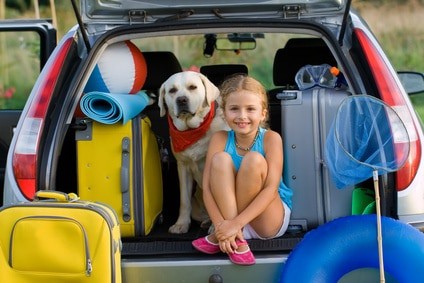Caravanning and camping holidays are a great way for families to enjoy the great outdoors together, and that should include the beloved family pet!
It is important to plan when travelling with pets and the following tips will provide you with the knowledge and ideas to make your holiday a pleasant one for all.
Did you know?
- It is illegal to drive in NSW with a pet on your lap. For safety pets must be restrained in a carrier or harness to prevent them moving around the car. (The laws regarding restraint of dogs in or on vehicles can vary between the states/territories).
- No dogs, cats, birds and other domestic pets (other than trained assistance animals such as guide dogs) must not be taken into national parks, state conservation areas, nature reserves, historic sites or Aboriginal areas.
Accommodation
- There are many caravan / holiday parks that welcome pets however pet policies may vary. When making your booking, contact the park directly to:
- Ensure that there has not been a change of policy; and
- Find out whether any conditions apply
- During your stay at a caravan / holiday park, make sure you:
- Respect the park’s regulations and be considerate of your fellow guests – don’t allow your pet to dominate the space.
- Always pick up any dog droppings.
- Keep your pet under control at all times, as much as for their safety as the safety of those around you.
Travelling
- Ensure your pet is comfortable and safe whilst travelling.
- For safety, pets must be restrained in a carrier or harness when travelling.
- Vehicle restraints for dogs are widely available and include restraints that either attach to existing seat belts or have buckles that clip directly into the seat belt.
- Transport containers should enable the animal to lie down comfortably in a natural position, stand and sit erect, turn around and stretch with clearance. Always ensure they are secure so it won’t slide or shift in the event of a quick stop.
- Do a trial run before your holiday as this will identify if they have a travel phobia. Consider several trial runs, lengthening the duration each time.
- A 30-minute drive on various surfaces and corners will be enough to see how they react. Anything that doesn’t happen is unlikely to occur during a longer trip.
- Never leave your pet unattended in a car even with the windows open, even in mild weather as pets can become stressed and overheat, leading to heat exhaustion.
- Pets suffer car sickness – symptoms shaking, drooling, extreme restlessness, anxiety, excessive barking or meowing. Their bodies feel the movement and of they cannot see out, the brain gets confused causing dizziness and vomiting.
- To assist with the prevention of car sickness, consider putting them in an area of the car that they can see out a window – use a baby booster seat to elevate height.
- If your pets suffer from severe car sickness talk to your vet about anti-nausea medication.
- Exercise your pet for approximately 20 minutes before your trip. This will allow them to burn off some energy and empty their bladder.
- Meals should be given at least 2 hours prior to travel. A full stomach may mean more toilet stops and worse case flatulence! Don’t feed your pet in a moving vehicle, even if it is a long drive.
- Moans mean something. They might feel hot, ill or need a toilet stop. Like humans take regular stops.
- Keep your pet on a lead when in an unfamiliar environment so that they are secure if they take fright at any unfamiliar sights or sounds.
- Fresh air is essential so it is recommended to travel with a window down however don’t allow your pet to ride with their head outside the window as they could be injured by flying objects.
- Ensure your pet is micro chipped and that your contact details are up to date and recorded on the microchip register. This will become important if they are lost.
- Ensure an ID tag is also attached with your contact details.
- Make sure your pet is healthy enough to travel and that all of their vaccinations, worming and flea treatment is up to date before setting off. If your pet takes any prescription medication make sure that you have enough to see you through the holiday. Talk to your vet for advice including paralysis tick prevention.
- Consider having the contact details of the local vet at your end destination or vet clinics along the way (if it’s a long trip) at hand in case you need to make an appointment.
- If you intend to travel extensively consider investing in rubberized floor liners and waterproof seat covers.
- When it comes to H2O, say BYO. Opt for bottled water or tap water stored in plastic jugs. Drinking water from an area they are not used to could result in tummy upset for your pet.
- Registration and Vaccination papers are essential if you want to leave your pet at a boarding kennel one day on your trip, such as when you want to visit a National Park where pets are not allowed. Kennels may refuse to take your pet if you are unable to provide proof of vaccinations. They are also required if you are traveling interstate, some states/territories require this proof at interstate crossings or you require a vet visit.
- As pets are exposed to a foreign environment as they travel a modified first aid kit is important. Common causes are ticks, snakes and unfamiliar food that react to the digestive system. A basic first aid kit should include antiseptic cream, bandages, scissors, tweezers, cotton wool & buds, salt & bicarbonate soda (mixed with water will induce vomiting), Tea Tree oil to use on ticks. These are basic items as a guide only.
To help you prepare download our Travelling with Pets Checklist.




